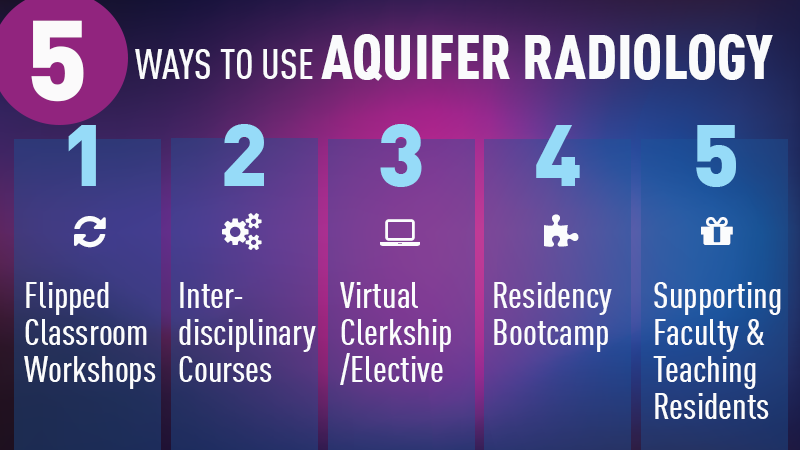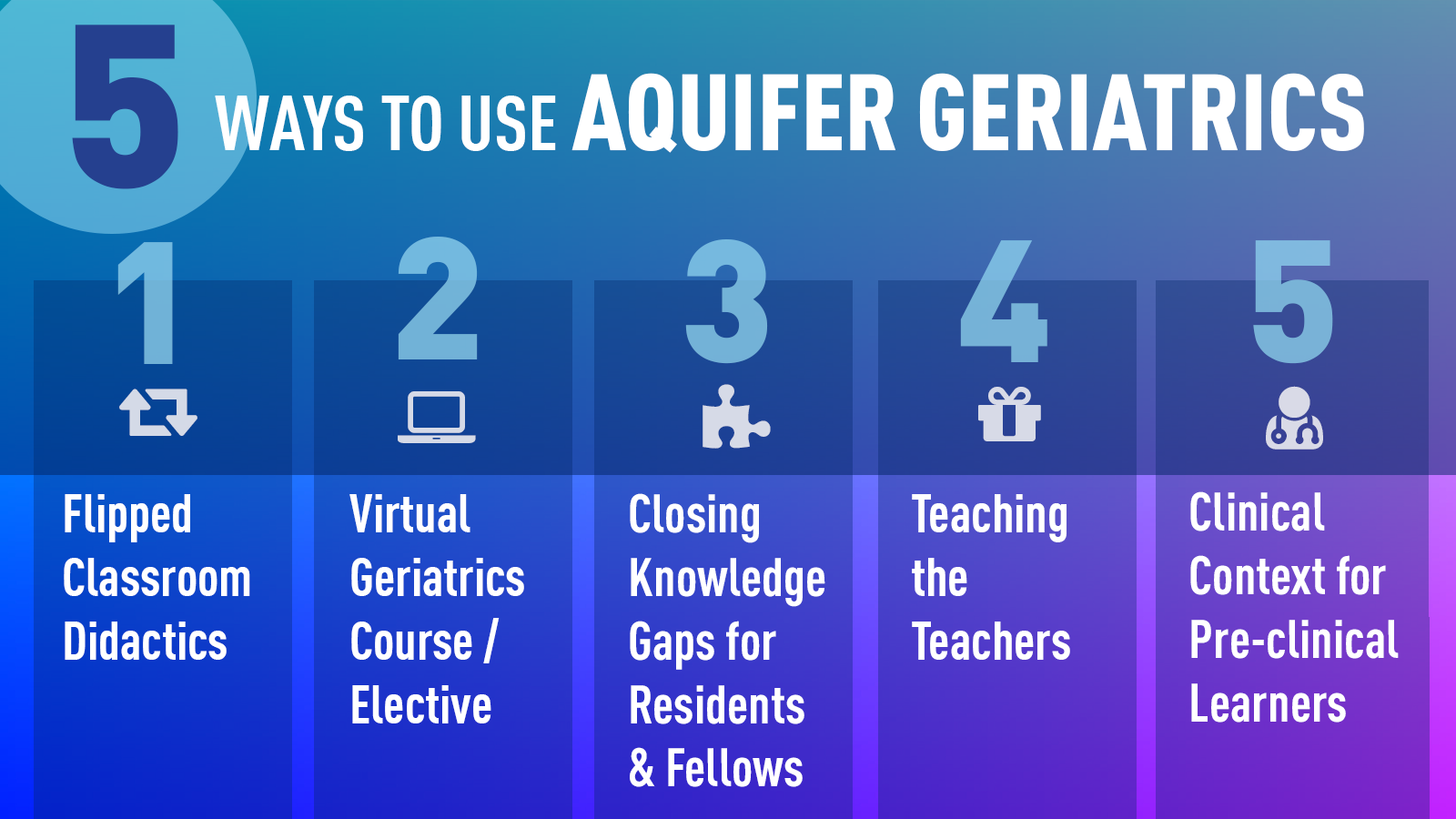4 min read
7 Tools for Flipping Your Classroom with Aquifer
Whether you’re searching for ways to engage students in virtual learning, revamping a stale lecture, or building a new didactic...

The 19 cases in Aquifer Radiology are designed to meet the needs of a wide range of learners and fit into many teaching modalities. In our recent webinar, Best Practices for Using Aquifer Radiology Across the Curriculum, top radiology educators around the country shared their successful strategies for integrating the cases. Here are their top tips for supporting learners (and teachers!) using our resources:
Aquifer Radiology’s Flipped Classroom workshops, available for 18 cases, provide a ready-made active learning session perfect for virtual or in-person learning. Each fully developed case presentation includes a PowerPoint complete with rich, high-quality images, annotations, and speaker notes. Presentations are designed to enhance the learning in the accompanying Aquifer case, supporting and emphasizing the learning points. Speaker notes are designed to engage learners through discussion questions, with answers provided.
The workshops are ideal for engaging residents and novice educators in teaching or supporting busy faculty with ready-made teaching sessions. The workshops are applicable to a range of learners.
For more details, watch Dr. Pauline Germaine present in our recent Aquifer Radiology webinar (5 minutes, starting at 12:54) or watch Dr. Jeff Hogg’s video overview of the Flipped Classroom Workshops (2 minutes). The Aquifer Radiology Flipped Classroom Workshops are available to all Aquifer Radiology subscribers in the Educator Resources section of your Aquifer account.
At the University of Nebraska College of Medicine, Dr. Melissa Manzer uses the Aquifer Radiology cases as a base for building radiology skills in fourth-year medical students through two different interdisciplinary courses. For faculty who are interested in integrating more diagnostic imaging into their curriculum, she suggests looking for gaps in your existing courses and working Aquifer Radiology’s framework into multi-disciplinary courses.
Dr. Manzer integrates the cases into her 4-week Diagnostic Radiology elective by assigning two Aquifer cases that match the content for the body system covered that week (chest, MSK, etc). The cases provide a quality resource for self-directed learning, allowing for minimal faculty involvement while covering key radiology concepts. Extra credit is awarded for completing additional cases.
During her school’s fourth-year Capstone Experience, Dr. Manzer takes advantage of a one-hour lecture to give the entire student body key information on best practices in imaging before graduation. She works through an extended clinical vignette (Aquifer Radiology case 5), pausing to integrate polls and surveys on how to apply the ACR appropriateness criteria to the patient scenario. This topic applies to students looking to enter any specialty, and gained broad support from interdisciplinary faculty, as all residents will need to be able to order the right diagnostic tests for their patients. Although she teaches the lecture herself, Dr. Manzer notes that a non-radiologist could easily teach the lecture using the Aquifer case and images as a framework.
For more details, watch Dr. Melissa Manzer present in our Aquifer Radiology webinar (10 minutes, starting at 25:11).
At the Keck School of Medicine University of Southern California, Dr. Sravanthi Reddy built a four-week elective virtual clerkship for third and fourth-year medical students. Her course required students to complete all 19 Aquifer Radiology cases on their own. She then used the Aquifer Radiology Flipped Classroom Workshops for interactive Zoom sessions on each case, taught by residents or attendings. The Aquifer content complemented the other learning methods for the course, which included one hour per day of readouts, ACR appropriateness criteria jeopardy, and “Learning Radiology”, an optional virtual book. She used a must-know PowerPoint and the Aquifer Radiology exam (with remote proctoring) for assessment. The elective earned high marks from students, several of whom wished they had taken the course earlier in their education (before their Step 1 exam).
To hear her full story, watch Dr. Sravanthi Reddy present in our Aquifer Radiology webinar (8 minutes, starting at 17:14).
At Harvard Medical School, Dr. Laura Avery created a virtual clerkship for students across three clinical sites that combined Aquifer Radiology cases, large group lectures, and small group homerooms using the Aquifer Radiology Flipped Classroom Workshops as an interactive learning activity. Find out more about Harvard’s approach in Dr. Avery’s blog: Virtual Radiology Clerkship to the Rescue; or read Medical Student Education Roadblock Due to COVID-19: Virtual Radiology Core Clerkship to the Rescue (Academic Radiology; Durfee, Golderson, Gill, Rincon, Flower, Avery) for full details on this virtual clerkship program, including methods, outcomes, and student evaluation data.
At Allegheny Health Network, Dr. Matt Miller addresses the variable exposure and experiences among his incoming radiology residents by creating a Bootcamp program using the Aquifer Radiology cases. Modeled after the program he experienced at West Virginia University, Dr. Miller’s two-week course provides a baseline of radiology knowledge for all those beginning their residency journey. He assigns two Aquifer Radiology cases nightly as homework and then uses the corresponding Aquifer Radiology Flipped Classroom Workshops for live teaching sessions twice a day (via Zoom). The sessions are driven by senior residents taking on the majority of the teaching responsibilities, with some faculty covering cases in their sub-specialties.
The Bootcamp program earned praise from incoming residents, who appreciated the structure of a shared knowledge base to help them understand the expectations for the residency program. It also provided an opportunity to build community among residents and allow new residents to get to know their senior residents, especially during COVID when in-person interactions were limited. Teaching residents enjoyed the experience, and several commented that they wished the program had been in place when they began their residency to help them get started.
For more information, hear Matt Miller, MD present on this topic (8 minutes, starting at 34:57) or watch Dr. Jeff Hogg’s 3 minute Residency Bootcamp User Story Video (West Virginia University).
The Aquifer Radiology Flipped Classroom Workshops make it easy for novice educators and busy faculty to succeed in teaching an engaging session. Developed by expert radiology educators, the workshops include everything instructors need to step in and deliver a quality learning experience.
At Keck School of Medicine University of Southern California, Dr. Reddy encourages first and second-year residents to learn by teaching third and fourth-year medical students in a virtual radiology clerkship. Resident teachers can choose a case related to their specialty and use the Aquifer Radiology Flipped Classroom Workshops to take on teaching a session. Residents report that they enjoy teaching, and improve their own knowledge as they do a deep dive into cases and topics through teaching the medical students.
At Allegheny Health Network, Dr. Miller builds community and develops teaching skills by having senior residents teach new residents using Aquifer Radiology as a framework for his residency bootcamp. With the Flipped Classroom Workshop powerpoints and speaker notes available, there is minimal preparation needed, reducing barriers for busy residents to get started teaching. Residents also reported that their teaching experience enhanced their exposure and knowledge on the topics, and several found it a good review for taking the boards, in addition to building community among residents.
For more information, be sure to watch Matt Miller, MD present on this topic (8 min, starting at 34:57); Dr. Sravanthi Reddy present in our Aquifer Radiology webinar (8 min, starting at 17:14), or Dr. Jeff Hogg’s 3 minute Residency Bootcamp User Story Video (West Virginia University).
For more from best practices your colleagues—and an overview of the Aquifer Radiology course—watch Best Practices for Using Aquifer Radiology Across the Curriculum on-demand or view our Aquifer Radiology User Stories.
Learn about the latest features and updates to our content and platform as they happen.

4 min read
Whether you’re searching for ways to engage students in virtual learning, revamping a stale lecture, or building a new didactic...

4 min read
The 27 cases in Aquifer Geriatrics are designed to meet the needs of a wide range of learners and fit into many teaching modalities....

3 min read
The COVID epidemic of spring 2020 swept through hospital-based medical student education like a tsunami. Fears of disease exposure,...